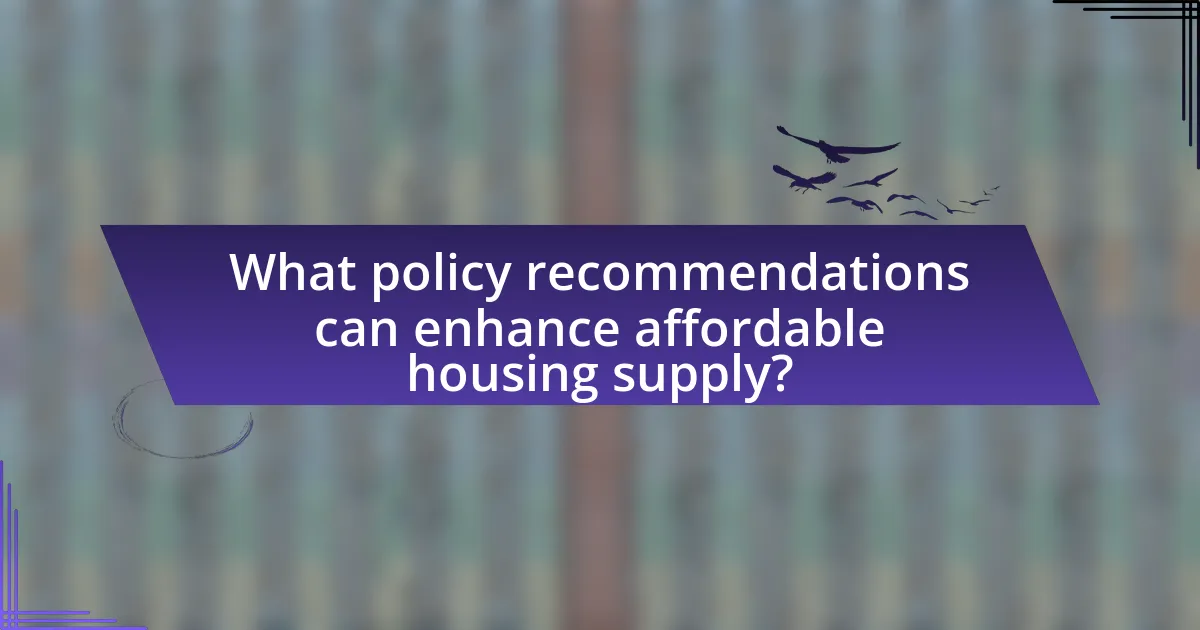The article focuses on policy recommendations for enhancing affordable housing supply in urban areas, addressing key challenges such as high land costs, regulatory barriers, and insufficient funding. It examines the influence of economic factors, income inequality, and zoning laws on housing availability, while highlighting the urgent need for effective solutions. The article outlines best practices for implementing affordable housing policies, including community engagement, public-private partnerships, and data-driven decision-making, ultimately aiming to provide actionable strategies for local governments and stakeholders to improve housing outcomes.

What are the key challenges in enhancing affordable housing supply in cities?
The key challenges in enhancing affordable housing supply in cities include high land costs, regulatory barriers, and insufficient funding. High land costs significantly increase the overall expense of housing development, making it difficult for developers to offer affordable units. Regulatory barriers, such as zoning laws and lengthy approval processes, can delay projects and discourage investment in affordable housing. Additionally, insufficient funding from both public and private sectors limits the ability to create and maintain affordable housing options. According to the National Low Income Housing Coalition, there is a shortage of 7 million affordable rental homes for extremely low-income renters, highlighting the urgency of addressing these challenges.
How do economic factors influence affordable housing supply?
Economic factors significantly influence the supply of affordable housing by affecting construction costs, land prices, and financing availability. For instance, rising material costs and labor shortages can increase the overall expense of building new homes, making it less feasible for developers to offer affordable units. Additionally, high land prices in urban areas can deter investment in affordable housing projects, as developers often prioritize higher-margin luxury developments. Furthermore, interest rates and lending conditions impact the ability of both developers and potential homeowners to secure financing, which can further constrain the supply of affordable housing. According to the National Association of Home Builders, a 1% increase in interest rates can reduce housing affordability by approximately 10%.
What role do housing prices play in the affordability crisis?
Housing prices significantly contribute to the affordability crisis by outpacing wage growth and increasing the cost burden on households. As housing prices rise, a larger portion of income is required for housing expenses, leading to a situation where many individuals and families cannot afford adequate housing. For instance, a report from the National Low Income Housing Coalition indicates that in 2021, a worker earning minimum wage could afford only 2.5% of rental listings nationwide, highlighting the disconnect between wages and housing costs. This disparity exacerbates the affordability crisis, making it increasingly difficult for low- and middle-income families to secure stable housing.
How does income inequality affect housing availability?
Income inequality significantly reduces housing availability by limiting access to affordable housing for lower-income individuals. As wealth becomes concentrated among a small percentage of the population, demand for high-end housing increases, driving up prices and making it difficult for lower-income families to compete in the housing market. For instance, a report from the National Low Income Housing Coalition indicates that in many urban areas, there is a shortage of affordable rental units, with only 37 affordable and available units for every 100 extremely low-income renters. This disparity exacerbates housing insecurity and homelessness, as those with lower incomes struggle to find suitable housing options.
What regulatory barriers exist to affordable housing development?
Regulatory barriers to affordable housing development include zoning restrictions, lengthy permitting processes, and building codes that increase costs. Zoning laws often limit the types of housing that can be built in certain areas, restricting density and the construction of multi-family units, which are essential for affordable housing. Lengthy permitting processes can delay projects, leading to increased costs and uncertainty for developers. Additionally, building codes may impose requirements that elevate construction expenses, making it financially unfeasible to develop affordable units. For instance, a study by the National Association of Home Builders found that regulatory costs can account for over 25% of the final price of a new home, significantly impacting affordability.
How do zoning laws impact housing supply?
Zoning laws significantly impact housing supply by regulating land use, density, and building types. These regulations can restrict the number of housing units that can be built in a given area, thereby limiting the overall supply of housing. For instance, strict zoning laws that favor single-family homes over multi-family units can lead to a shortage of affordable housing options, as seen in cities like San Francisco, where zoning restrictions have contributed to a housing crisis. Additionally, zoning laws can create barriers to new developments, increasing costs and reducing the incentive for builders to construct new housing. This relationship between zoning regulations and housing supply is supported by studies indicating that areas with more flexible zoning policies tend to have higher housing availability and affordability.
What are the effects of building codes on affordable housing projects?
Building codes significantly impact affordable housing projects by establishing minimum safety, health, and structural standards that must be met. These regulations can increase construction costs and project timelines, which may deter developers from pursuing affordable housing initiatives. For instance, a study by the National Association of Home Builders found that stringent building codes can add up to 25% to the cost of construction, making it less feasible for developers to create low-cost housing options. Additionally, complex compliance processes can lead to delays, further exacerbating the housing shortage in urban areas.
What social factors contribute to the need for affordable housing?
Social factors contributing to the need for affordable housing include rising income inequality, increasing population density, and the lack of living wage jobs. Rising income inequality has led to a significant portion of the population earning wages that do not keep pace with housing costs, making it difficult for many to afford adequate housing. Increasing population density in urban areas exacerbates competition for limited housing resources, driving prices higher. Additionally, the lack of living wage jobs means that even full-time workers struggle to meet housing expenses, further increasing the demand for affordable housing options. According to the U.S. Department of Housing and Urban Development, nearly 11 million renters in the United States are considered “cost-burdened,” spending more than 30% of their income on housing, highlighting the urgency of addressing these social factors.
How does population growth affect housing demand?
Population growth increases housing demand due to a larger number of individuals requiring living spaces. As more people move into an area, the need for housing rises, leading to higher occupancy rates and increased competition for available properties. For instance, the U.S. Census Bureau reported that from 2010 to 2020, the U.S. population grew by approximately 7.4%, which directly correlated with a surge in housing demand in urban areas. This heightened demand can result in rising property prices and rental rates, making it more challenging for low- and moderate-income families to secure affordable housing.
What is the impact of homelessness on urban housing policies?
Homelessness significantly influences urban housing policies by prompting governments to prioritize affordable housing initiatives and implement supportive services. The presence of homelessness in urban areas often leads to increased public awareness and pressure on policymakers to address housing shortages, resulting in the development of policies aimed at increasing the supply of affordable housing. For instance, cities like Los Angeles have adopted measures such as the “Measure H” initiative, which allocates funding for homelessness prevention and affordable housing development, demonstrating a direct response to the challenges posed by homelessness. Additionally, research indicates that cities with higher rates of homelessness tend to invest more in housing-first approaches, which prioritize providing stable housing as a means to reduce homelessness and improve overall community health.

What policy recommendations can enhance affordable housing supply?
Policy recommendations that can enhance affordable housing supply include increasing funding for affordable housing development, implementing inclusionary zoning policies, and streamlining permitting processes. Increased funding can be achieved through government grants and tax incentives, which have been shown to stimulate construction of affordable units. Inclusionary zoning mandates that a percentage of new developments be set aside for low-income residents, effectively increasing the stock of affordable housing. Streamlining permitting processes reduces delays and costs associated with construction, making it more feasible for developers to build affordable units. These strategies have been supported by studies indicating that cities employing such policies see a measurable increase in affordable housing availability.
How can government incentives promote affordable housing development?
Government incentives can promote affordable housing development by providing financial support, tax breaks, and regulatory relief to developers. These incentives lower the cost of construction and increase the profitability of affordable housing projects. For instance, the Low-Income Housing Tax Credit (LIHTC) program in the United States has successfully facilitated the creation of over 3 million affordable housing units since its inception in 1986, demonstrating the effectiveness of such incentives in stimulating development. Additionally, grants and subsidies can directly reduce the financial burden on developers, making it more feasible to invest in affordable housing initiatives.
What types of financial incentives are most effective?
The most effective types of financial incentives for enhancing affordable housing supply in cities include tax credits, direct subsidies, and low-interest loans. Tax credits, such as the Low-Income Housing Tax Credit (LIHTC), have been shown to stimulate private investment in affordable housing, resulting in the creation of over 2.9 million affordable housing units since its inception in 1986. Direct subsidies, which provide financial assistance to developers or renters, can significantly lower construction costs and increase affordability. Additionally, low-interest loans can reduce the financial burden on developers, making it more feasible to invest in affordable housing projects. These incentives have proven successful in various cities, demonstrating their effectiveness in addressing housing shortages.
How can tax credits support affordable housing initiatives?
Tax credits can significantly support affordable housing initiatives by providing financial incentives that encourage developers to invest in low-income housing projects. These credits reduce the overall cost of construction or rehabilitation, making it more feasible for developers to create and maintain affordable units. For instance, the Low-Income Housing Tax Credit (LIHTC) program has facilitated the development of over 3 million affordable housing units since its inception in 1986, demonstrating its effectiveness in stimulating investment in this sector. By lowering the financial barriers, tax credits help ensure that affordable housing remains accessible to low-income families, thereby addressing housing shortages in urban areas.
What role does public-private partnership play in housing supply?
Public-private partnerships (PPPs) play a crucial role in enhancing housing supply by leveraging resources, expertise, and financing from both sectors to develop affordable housing projects. These collaborations enable governments to address housing shortages more effectively by sharing risks and costs, thus accelerating project delivery. For instance, a study by the Urban Institute highlights that PPPs can reduce the time and financial burden on public entities while increasing the scale of housing developments, leading to a more significant impact on affordable housing availability.
How can collaboration between sectors improve housing outcomes?
Collaboration between sectors can significantly improve housing outcomes by leveraging diverse resources, expertise, and perspectives to address complex housing challenges. For instance, partnerships between government agencies, non-profit organizations, and private developers can facilitate the pooling of financial resources, enabling the construction of affordable housing units. A study by the Urban Institute found that collaborative efforts in housing policy can lead to a 20% increase in the availability of affordable housing options in urban areas. Additionally, cross-sector collaboration can enhance the effectiveness of housing programs by integrating social services, which address underlying issues such as homelessness and unemployment, ultimately leading to more sustainable housing solutions.
What successful models of public-private partnerships exist?
Successful models of public-private partnerships (PPPs) include the Housing Authority of the City of Los Angeles (HACLA) and the Los Angeles County Development Authority (LACDA) collaboration, which has effectively increased affordable housing units through joint financing and resource sharing. Another example is the Partnership for Sustainable Communities, a collaboration between the U.S. Department of Housing and Urban Development, the U.S. Department of Transportation, and the U.S. Environmental Protection Agency, which promotes integrated approaches to housing and transportation, leading to enhanced community development. These models demonstrate how strategic partnerships can leverage public and private resources to address housing shortages effectively.
How can community engagement shape housing policies?
Community engagement can significantly shape housing policies by ensuring that the voices and needs of residents are incorporated into decision-making processes. When local communities actively participate in discussions about housing, they provide valuable insights into their specific challenges and preferences, which can lead to more effective and equitable policies. For instance, studies have shown that cities with robust community engagement initiatives, such as participatory budgeting or public forums, often develop housing policies that better reflect the needs of diverse populations, resulting in increased satisfaction and reduced displacement. This approach not only fosters trust between residents and policymakers but also enhances the overall effectiveness of housing strategies by aligning them with the actual demands of the community.
What strategies can be used to involve local residents in planning?
To involve local residents in planning, strategies such as community engagement workshops, participatory budgeting, and surveys can be effectively utilized. Community engagement workshops allow residents to voice their opinions and contribute ideas directly, fostering a sense of ownership in the planning process. Participatory budgeting enables residents to have a say in how public funds are allocated, ensuring that their priorities are addressed. Surveys can gather broader input from the community, providing valuable data on resident needs and preferences. These strategies have been shown to enhance transparency and trust between local governments and residents, ultimately leading to more effective and accepted planning outcomes.
How does community feedback influence policy effectiveness?
Community feedback significantly enhances policy effectiveness by ensuring that policies are aligned with the actual needs and preferences of the population they serve. When community members provide input, policymakers can identify gaps in existing policies and make informed adjustments that reflect the realities of housing challenges. For instance, studies have shown that cities that actively engage residents in the policy-making process, such as through public forums or surveys, often see higher satisfaction rates and better compliance with housing regulations. This is evidenced by the success of participatory budgeting initiatives in cities like Porto Alegre, Brazil, where community involvement led to more effective allocation of resources and improved housing conditions.

What are the best practices for implementing affordable housing policies?
The best practices for implementing affordable housing policies include establishing clear goals, engaging stakeholders, and utilizing data-driven approaches. Clear goals help define the scope and objectives of affordable housing initiatives, ensuring alignment with community needs. Engaging stakeholders, including local governments, non-profits, and residents, fosters collaboration and support, which is crucial for successful implementation. Data-driven approaches, such as analyzing housing market trends and demographic needs, enable policymakers to make informed decisions and allocate resources effectively. For instance, cities like Minneapolis have successfully implemented policies that prioritize affordable housing through comprehensive planning and community engagement, resulting in increased housing availability and reduced displacement.
How can cities effectively monitor and evaluate housing policies?
Cities can effectively monitor and evaluate housing policies by implementing data-driven approaches that include regular assessments of housing stock, affordability metrics, and resident satisfaction surveys. These methods allow cities to track changes in housing availability and affordability over time, ensuring that policies are responsive to community needs. For instance, cities can utilize Geographic Information Systems (GIS) to analyze spatial data related to housing trends, which has been shown to enhance decision-making processes. Additionally, engaging with stakeholders through public forums and feedback mechanisms can provide qualitative insights that complement quantitative data, leading to more comprehensive evaluations of housing policies.
What metrics should be used to assess policy impact?
To assess policy impact in enhancing affordable housing supply in cities, key metrics include housing affordability index, housing supply growth rate, and occupancy rates. The housing affordability index measures the proportion of income spent on housing, indicating the financial burden on residents. The housing supply growth rate tracks the increase in available affordable units over time, reflecting the effectiveness of policies aimed at increasing supply. Occupancy rates provide insight into the demand for affordable housing, showing how well the available units are being utilized. These metrics collectively offer a comprehensive view of policy effectiveness in addressing housing needs.
How can data collection improve housing policy decisions?
Data collection can significantly improve housing policy decisions by providing evidence-based insights into housing needs, market trends, and demographic shifts. Accurate data allows policymakers to identify areas with the greatest demand for affordable housing, assess the effectiveness of existing policies, and allocate resources more efficiently. For instance, a study by the Urban Institute found that cities utilizing comprehensive data analytics were able to reduce housing shortages by 20% over five years by targeting investments in high-need areas. This demonstrates that informed decision-making, driven by robust data collection, leads to more effective housing policies and ultimately enhances the supply of affordable housing in urban environments.
What lessons can be learned from successful affordable housing initiatives?
Successful affordable housing initiatives demonstrate the importance of community engagement and collaboration among stakeholders. Engaging local communities in the planning process ensures that the housing solutions meet their specific needs, as evidenced by the success of the Community Land Trust model, which has effectively provided affordable housing while maintaining community control in various cities. Additionally, leveraging public-private partnerships has proven effective; for instance, the partnership between the city of San Diego and private developers led to the creation of over 1,000 affordable units through streamlined permitting processes and financial incentives. These initiatives highlight the necessity of adaptable policies that can respond to local market conditions and the importance of sustained funding sources, such as the Low-Income Housing Tax Credit, which has financed over 3 million affordable housing units since its inception.
What case studies demonstrate effective policy implementation?
Case studies that demonstrate effective policy implementation in enhancing affordable housing supply include the inclusionary zoning policy in San Francisco and the Housing First model in Finland. San Francisco’s inclusionary zoning mandates that a percentage of new housing developments be affordable, resulting in over 1,500 affordable units created between 2002 and 2018. In Finland, the Housing First approach has successfully reduced homelessness by providing permanent housing without preconditions, leading to a 35% decrease in homelessness since its implementation in 2008. These examples illustrate how targeted policies can effectively address housing challenges in urban environments.
How can these lessons be adapted to different urban contexts?
Lessons on enhancing affordable housing supply can be adapted to different urban contexts by tailoring strategies to local demographics, economic conditions, and regulatory environments. For instance, cities with high population density may benefit from policies promoting vertical housing developments, while those with lower density might focus on expanding suburban housing options. Additionally, understanding local income levels can guide the implementation of income-targeted housing subsidies. Research indicates that cities like New York and San Francisco have successfully adapted inclusionary zoning policies to their unique housing markets, demonstrating that localized approaches can effectively address specific urban challenges.
What practical steps can cities take to enhance affordable housing supply?
Cities can enhance affordable housing supply by implementing inclusionary zoning policies that require developers to allocate a percentage of new housing units for low-income residents. This approach has been adopted in cities like San Francisco, where inclusionary zoning has led to the creation of thousands of affordable units. Additionally, cities can streamline permitting processes to reduce development costs and encourage the construction of affordable housing. For instance, Minneapolis has successfully reduced bureaucratic hurdles, resulting in increased housing development. Furthermore, cities can invest in public-private partnerships to leverage private funding for affordable housing projects, as seen in New York City’s Housing New York plan, which aims to create or preserve 300,000 affordable homes by 2026. These practical steps, supported by successful case studies, demonstrate effective strategies for enhancing affordable housing supply.
What immediate actions can local governments implement?
Local governments can implement immediate actions such as increasing funding for affordable housing projects, streamlining zoning regulations, and enhancing partnerships with non-profit organizations. Increasing funding can be achieved through reallocating budget resources or leveraging federal grants, which can directly support the construction and rehabilitation of affordable units. Streamlining zoning regulations allows for faster approvals and encourages the development of diverse housing types, addressing the urgent need for affordable options. Additionally, enhancing partnerships with non-profit organizations can facilitate community engagement and mobilize resources effectively, as evidenced by successful collaborations in cities like San Francisco, where such partnerships have led to the creation of thousands of affordable housing units.
How can stakeholders collaborate for sustainable housing solutions?
Stakeholders can collaborate for sustainable housing solutions by forming partnerships that integrate diverse expertise and resources. This collaboration can involve government agencies, non-profit organizations, private developers, and community groups working together to create policies that promote eco-friendly building practices, affordable housing, and community engagement. For instance, the U.S. Green Building Council’s LEED certification program encourages collaboration among stakeholders to implement sustainable design and construction practices, which has led to a significant increase in energy-efficient buildings. Additionally, joint funding initiatives can be established to support projects that prioritize sustainability, ensuring that all parties contribute to and benefit from the outcomes.



